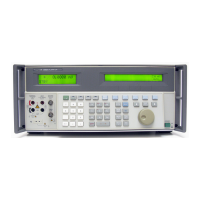5500A
Operator Manual
3-10
CALIBRATION
ENABLE
SERIAL 1
FROM HOST
IEEE-488
BOOST AMPLIFIER
TO CLEAN FILTER REMOVE FROM INSTRUMENT
AND FLUSH WITH SOAPY WATER
/ 63Hz
47Hz
300VA MAX
FLUKE CORPORATION
MADE IN USA
PATENTS PENDING
NO INTERNAL USER SERVICEABLE
PARTS. REFER SERVICE TO
QUALIFIED SERVICE PERSONNEL
NORMAL
WARNING
GROUNDING CONNECTOR IN POWER CORD MUST BE
CONNECTED TO ENSURE PROTECTION FROM ELECTRIC SHOCK
FUSE
CAUTION
FOR FIRE PROTECTION
REPLACE ONLY WITH A 250V FUSE
OF INDICATED RATING
MAINS SUPPLY
/120V 100V
/240V
220V
T2.5A 250V
(SB)
T1.25A 250V
(SB)
CHASSIS
GROUND
SERIAL 2
TO UUT
1 2
3 4
56
7
8
F3-02.eps
Figure 3-2. Rear Panel View
Table 3-2. Rear Panel Features
1
The Fan Filter covers the air intake to keep dust and debris out of the chassis air baffles. The
5500A fan provides a constant cooling air flow throughout the chassis. Fan filter maintenance is
described in Section 7, Maintenance.
2
The CALIBRATION NORMAL/ENABLE slide switch is used to write enable and disable the
nonvolatile memory that stores calibration constants. Switching to ENABLE allows changes to be
written into memory, and switching to NORMAL protects data in memory from being overwritten.
The switch is recessed to allow it to be covered with a calibration sticker to guarantee calibration
integrity.
3
The SERIAL 2 TO UUT connector is used for transmitting and receiving RS-232 serial data
between the 5500A and an RS-232 port on a Unit Under Test (UUT). Chapter 6, “Remote
Commands” describes how to use the RS-232 serial interface for UUT communications.
4
The SERIAL 1 FROM HOST connector is used for remote control of the 5500A and for
transmitting internal-constant RS-232 serial data to a printer, monitor, or host computer. Chapter
5, “Remote Operation” describes how to use the RS-232 serial interface for remote control.
5
The BOOST AMPLIFIER connector provides the analog and digital interface for the Fluke 5725A
Amplifier. After connecting the 5725A to the connector, you control the 5725A from the 5500A
front panel or by remote commands. Refer to “Using an Auxiliary Amplifier” in Chapter 4, “Front
Panel Operation” for details.

